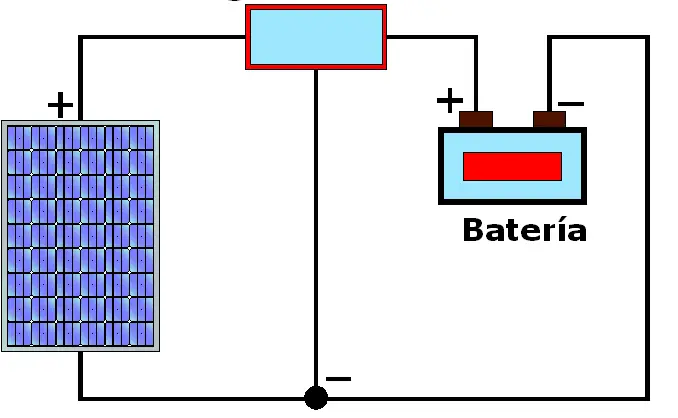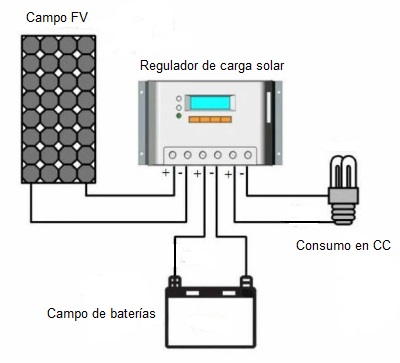Charge controller is a device located between photovoltaic modules and batteries as an element of an isolated solar system.
Modules output voltage is set some volts higher than voltage battery needs to charge. The reason is to ensure that modules will always be able to charge the battery, even when cell temperature is high and generated voltage decreases.
This causes the drawback that once battery reaches its full charge state, module continues to try to inject energy producing an overload that, if not avoided, can destroy battery.
Charge controller is responsible for extending batteries life protecting them from overload situations, controlling load phases depending on their status and even reaching the cut depending on load needs of them.
Charge controllers may be working in one of the following situations:
– Equalization status: equalization of batteries charge, after a period of low charge.
– Deep charging state: regulation system allows charging until reaching final load voltage point.
– Float state: battery has reached a charge level close to 90% of its capacity.
– State of final charge and flotation: regulation system zone of action within Dynamic Flotation Band (range between final load voltage and nominal voltage + 10%).
To know which regulator to incorporate into a photovoltaic system it is necessary to know some elementary parameters.
First, one is isolated solar system nominal voltage. Batteries voltage and photovoltaic solar field define this voltage. Typical values are 12, 24, 48 and up to 60 volts.
The other parameter is photovoltaic modules system load current. It is recommended to multiply short circuit current Isc under standard conditions by 1.25 so that charge controller is always able to withstand current produced by modules.
Known system voltage and determined current value, we can choose the right charge controller. If there are still doubts, we can consult with provider technical department.
The simplest design is one that involves a single stage of control. Charge controller constantly monitors battery voltage but controls charge or discharge, never both. They are the cheapest and the simplest.
This can be achieved by opening the circuit between photovoltaic modules and battery (serial control) or by short-circuiting photovoltaic modules (shunt control).

In case of controllers that operate in two control stages, the two functions are controlled, both charge and discharge of battery. They are more expensive, but they are the most used.
Current charge controllers introduce microcontrollers and control 3 and up to 4 control stages.

During last years a new generation of charge controllers has been developed, whose main characteristics are to make photovoltaic field work at maximum working point and to always render it optimally.
These charge controllers are known as power maximizers or MPPT.
Another advantage of these devices compared to conventional controllers is the possibility of working with a different voltage in the generator field (solar panels) and batteries.
This directly influences in being able to put several modules in series, elevating system tension.
Working with lower currents we can reduce considerably voltage drop losses and use smaller cable sections and therefore of lower price.
For the choice of a conventional controller or an MPPT, we have to assess cost overruns that these systems have compared to benefits that it gives us due to system performance increase. In some cases, annual power increase can reach up to 30% compared to conventional controller.

Charge controller may not be essential in installations where the ratio between modules power and battery capacity is very small (eg: oversized batteries for safety reasons) so that charging current can hardly damage battery.
If modules field power in W is less than 1/100 battery capacity in W / h, charge controller may not be incorporated.
It can also be dispensed with a charge controller if system has self-regulated solar modules (not recommended for extreme climates).
This is an extract of contents included in Technical-Commercial Photovoltaic Solar Energy Manual and Sopelia e-learning training.
All you need is Sun. All you need is Sopelia.

Queridos amigos recban un saludo desde peru braem muy buenos dias deseo hacer un conentario y depaso una pregunta si yo instalo 2 pales solares y 2 baterias 12 como seria lo recomendable en serie o en paralelo gracias que dios los vendiga grandemente
Hola Valerio. Gracias por tu mensaje. Todo depende de la carga a la que deseas aportar energía. Si conectas 2 modulos en serie, duplicas el valor del voltaje de cada uno y se mantiene la intensidad unitaria. Si conectas 2 modulos en paralelo, duplicas el valor de la intensidad de cada uno y se mantiene el voltaje unitario. Para más información visita http://www.sopelia.com Saludos
La energía renovable es el futuro y el equilibrio de nuestro planeta, como lo apreciamos con estos ejemplos.
Hola Juan. Gracias por tus comentarios. Para más información visita http://www.sopelia.com Saludos